















|
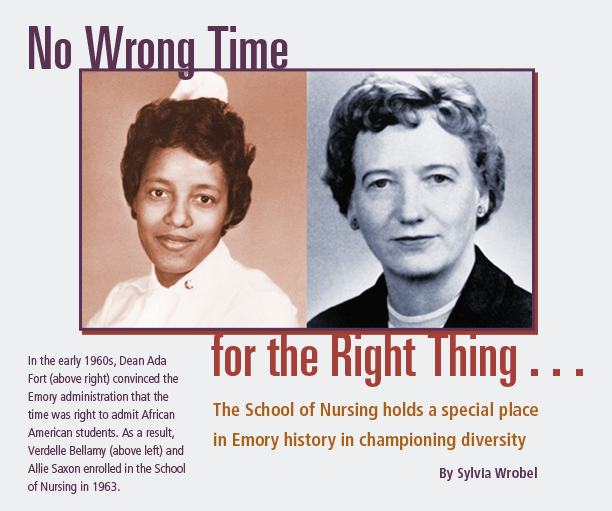
 |
 ver
the years, Emory’s nursing deans have shared a determination
to make the school and its graduates more fully reflect the
spectrum of American society—and impatience with any
obstacles in the way. As the Nell Hodgson Woodruff School
of Nursing pushes forward with an ambitious strategic plan
that links the domestic and global nursing shortage with a
need to further diversify the face of nursing, it is inspiring,
says Dean Marla Salmon, to look back on the bravery and determination
of those earlier leaders, students, and supporters who opened
the diversity doors at Emory University. Today’s school
is building on a strong legacy set forth by former nursing
dean Dr. Ada Fort, who boldly challenged Georgia’s segregation
laws in the early 1960s based on the principle: “There’s
never a wrong time to do the right thing.” ver
the years, Emory’s nursing deans have shared a determination
to make the school and its graduates more fully reflect the
spectrum of American society—and impatience with any
obstacles in the way. As the Nell Hodgson Woodruff School
of Nursing pushes forward with an ambitious strategic plan
that links the domestic and global nursing shortage with a
need to further diversify the face of nursing, it is inspiring,
says Dean Marla Salmon, to look back on the bravery and determination
of those earlier leaders, students, and supporters who opened
the diversity doors at Emory University. Today’s school
is building on a strong legacy set forth by former nursing
dean Dr. Ada Fort, who boldly challenged Georgia’s segregation
laws in the early 1960s based on the principle: “There’s
never a wrong time to do the right thing.”
At the middle of the 20th century,
Emory, like virtually all Southern universities, was a monotony
of white skin, save for an occasional Asian or Asian American
student. But the country was changing, with Georgia representing
both sides of the racial coin. It was home to civil rights
leader Dr. Martin Luther King Jr., while its governor and
legislature threatened to close down the public school system
rather than comply with the 1954 US Supreme Court ruling ordering
public schools to integrate. Emory faculty were among the
loudest voices raised in favor of integration. In 1961, Georgia
gave in, removing all laws requiring racial segregation of
public education. Within days, the arrival of two black students
on the University of Georgia (UGA) campus set off riots.
There was a cruel catch in the
new law. While public schools like UGA were now required to
admit qualified black students, private schools like Emory
were prohibited from doing so. Breaking the law meant losing
the tax-exempt status that private schools needed to operate.
Everyone knew that Emory was going to fight that law. The
question, given the tensions and politics of the era, was
when? Fort argued for now.
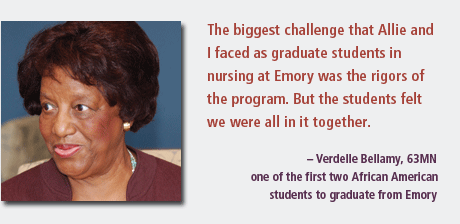
A Quiet Revolution
In 1962, she quietly began a search for two African American
women with the nursing background that would enable them to
succeed in the school’s vigorous master’s degree
program—the first master of nursing program in the Southeast,
then 8 years old—and the strength to withstand any heat
they might encounter. To find such bright, brave women, Fort
turned to Dorothy Tilly, who was working to help Martin Luther
King gain support in the white community while ignoring burning
crosses in her own front yard.
“Mrs. Tilly asked me to
lunch,” recalls Verdelle Bellamy, 63MN, “and told
me Emory’s nursing school was ready to enroll African
Americans.” Bellamy would be a pioneer, Tilly pointed
out, and would get a great graduate education in her field
of maternal and child health.
When the flabbergasted
Bellamy asked why her, Tilly only smiled. “Verdelle,”
she said, “we know more about you and your family than
you probably know yourself!”
When Tilly pulled the Emory
application out of her case that day, Bellamy’s life
was set to go in a different direction, at least geographically.
She, like Allie Saxon, 63MN, who would join her in integrating
Emory’s nursing school, had received her diploma degree
from Grady Memorial Hospital’s School of Nursing. Bellamy
remained to work in the segregated black hospital at Grady.
Later, Bellamy and Saxon went to Tuskegee Institute in Alabama,
the nearest place where a black person in Atlanta could get
a bachelor’s degree in nursing and become a registered
nurse.
By 1962, Bellamy was on the
faculty of the Grady nursing program. Saxon, who taught at
Carver High School, brought vocational nursing students to
Grady for clinical experience. The two friends assumed they
would have to head north to advance their nursing credentials,
and Bellamy had been accepted at Case Western Reserve in Cleveland,
Ohio, for that fall.
“I’ve never been
a person to shy away from opportunities or obligations,”
says Bellamy. “I thought Emory was trying to change
attitudes. So I talked it over with my husband, and I agreed
to accept the challenge.” So did Saxon.
Their applications arrived at
the nursing school, were reviewed, and added to the stack
sent to the central university for admission. Soon thereafter,
Henry Bowden, the supportive but ever-politic chair of Emory’s
Board of Trustees, came to Fort’s office in the nursing
school and politely made the case for patience. Fort stuck
to her mantra: no wrong time for the right thing. Virginia
Proctor, a nursing school administrator at the time, believes
having already admitted two students was an important factor
in the board’s decision to push ahead then, rather than
later.
Bowden and Ben Johnson Jr.,
dean of the School of Law (and father of Emory’s current
board chair), lost the first round of Emory’s case in
a lower court and immediately appealed. As the legal battle
dragged on, Fort grew more impatient. If the students entered
before the law was overturned, Emory would suffer financially.
If they didn’t begin by fall, they would be out of sequence
in the intense curriculum. Fort called Dr. Benjamin Mays,
president of Morehouse College, explaining she had two students
who needed science courses in order not to miss any time toward
the goal they were trying to reach. The following Monday,
in fall 1962, Bellamy and Saxon were enrolled in a swiftly
stitched-together class schedule in chemistry and biology
at Clark Atlanta University.
In September, Bowden and Johnson
won Emory’s case in the Georgia Supreme Court. Most
of the divisions at Emory had already begun classes, but the
Graduate School of Arts and Sciences arranged for a black
male student to enroll part-time in a special program. Emory
was officially integrated.
The following January, Bellamy
and Saxon arrived at the dilapidated Army barracks that housed
Emory’s nursing school. As they reached out their hands,
the door swung open from inside. Waiting to greet them were
Fort and the entire nursing school faculty and student body.
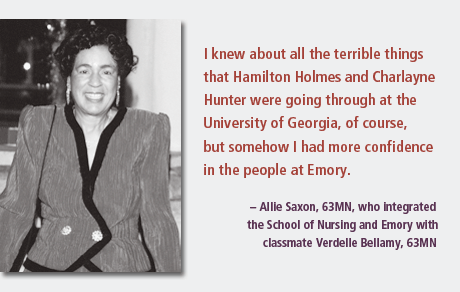
It was the first time any of
them, black or white, had classmates of the opposite color.
All had seen horrific pictures on television—fire hoses
mowing down protesters, family pictures of the little girls
who died in an Alabama church bombing, and the faces of their
grieving parents. Some of them doubtless knew how their own
families felt about the changes sweeping the nation.
“I just wasn’t worried,”
recalls Saxon. “I knew about all the terrible things
that Hamilton Holmes and Charlayne Hunter were going through
at the University of Georgia, of course, but somehow I had
more confidence in the people at Emory.”
“We were completely welcomed,”
Bellamy says. “We experienced nothing bad. The biggest
challenge that Allie and I faced as graduate students in nursing
at Emory was the rigors of the program. But the students felt
we were all in it together, and we often studied together.”
Fort had chosen well. Both Bellamy
and Saxon were serious, highly organized students who mixed
easily with their classmates. In December 1963, they became
the first African American students to receive an Emory degree.
After graduation, Bellamy joined
the Veterans Affairs medical system, retiring at the rank
of associate chief of geriatrics in the VA’s long-term
care facility. Saxon joined the faculty at Winston-Salem State
College in North Carolina, which had a training agreement
with Grady, then moved to the US Department of Health and
Human Services in Atlanta. Her last position before retiring
was as a contractor representative for Medicare.
Both women have often been honored
at Emory, but what pleases them most is the knowledge that
the door they opened at Emory—and in the places where
they have worked—has opened wider for other students.
Bellamy and Saxon may have made
integration look easy, but the outside world was far from
that. Retired nursing professor Rose Dilday remembers when
one of the early black graduate students who followed those
first pioneers phoned her in tears. Dilday had placed the
student, one of her best, in a local mental health facility
for a clinical rotation, and the secretaries refused to let
her use the restroom. Dilday stepped in, as the faculty always
did. The harassed student went on to become director of the
county’s mental health program.
“Standing in the shadow
of integration took a lot of energy,” recalls Virginia
Proctor. That’s why she was astonished when shortly
after the school was integrated that Fort announced in a faculty
meeting, “We in America are the most well cared for
medically anywhere in the world, with the most hospitals,
most doctors, most nurses. This places upon us a responsibility
to do something about health around the world.”
“My first thought was
not yet, Ada, not yet, we haven’t yet dusted ourselves
off from what we have just been though,” says Proctor.
“But then I realized our own students were saying the
same thing.” Many university student abroad programs
sent students to European capitals; the nursing school then
as now more often sent its students to the poorest nations
of the world. It was part of a lasting goal to promote global
diversity and awareness among nursing students, faculty, and
professionals.
And it worked. The private,
nonprofit International Nursing Services Association that
grew out of Fort’s pronouncement later expanded into
Global Health Action (GHA), which has trained more than 6,000
nurses, home health workers, and other health professionals
in 87 countries. (Coincidentally, GHA is led by Robin Davis,
a 1976 graduate of the master’s program.) “I hope
somewhere Dean Fort is watching the success of the Lillian
Carter Center for International Nursing today,” adds
Salmon, who established the center in 2001 to address global
issues in health
care and the nursing workforce.
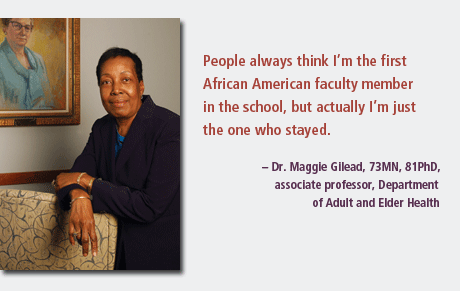
Staying
the Course
People always think I’m the first African American faculty
member in the school,” laughs Dr. Maggie Gilead, 73MN,
81PhD, “but actually I’m just the one who stayed.”
When Gilead joined the faculty as an instructor in 1974, Mackie
Norris, who was the first, had taught for a little over a
year before following her husband to another city.
Gilead was working at Grady
when she enrolled in the school’s new mental health
clinical nurse specialty program in 1972. “It was a
little perplexing to be at Emory in the 1970s,” remembers
Gilead. “Race wasn’t an issue for me, especially
since I was in that protected group of Rose Dilday’s
students. But I was one of only two students who were not
from the South, and I sometimes felt discriminated against
by both blacks and whites who saw me as a Yankee.” Gilead
took an educational leave to attend Emory’s Institute
of Liberal Arts to study psychology and urban studies and
in 1981 became one of the first teachers on the nursing faculty
to hold a doctorate. Now an associate professor in the Department
of Adult and Elder Health, she is a leader in improving mental
health services at the local and state level. Her joint appointment
in 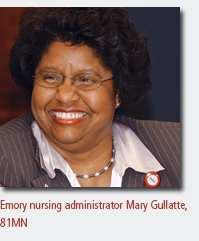 Emory’s
Department of African American Studies also reflects the school’s
increasing involvement with the university that has, she believes,
helped erase an earlier sense of isolation. Emory’s
Department of African American Studies also reflects the school’s
increasing involvement with the university that has, she believes,
helped erase an earlier sense of isolation.
Mary Gullatte, 81MN, helped
diversify the staff at Emory University Hospital. When she
joined the hospital in 1978, she was one of five African American
nurses. Historically, most African American women were guided
to pursue training as licensed practical nurses. Some Emory
patients looked first at Gullatte’s skin color and asked
about her credentials. Most responded as quickly to her professionalism
as to her RN status, but when a recalcitrant patient crossed
the line, the oncologists were on the spot as Gullatte’s
champion, ready to discharge the patient before allowing abuse
of a nurse.
Exuding a conviction that she
could excel in whatever she set her mind to, Gullatte worked
and raised a family while completing her master’s at
the nursing school and then the advanced practice nurse practitioner
program. “I marvel at the things the school had to offer
and the support I received,” says Gullatte, “and
I’m grateful for the pioneers like Verdelle Bellamy
and Allie Saxon, who paved the way.”
Gullatte continues the work
they began. Now director of nursing for patient oncology and
transplant services for Emory Hospitals and the Winship Cancer
Institute, she was named 2004 Georgia Nurse of the Year. She
is studying for her doctorate and remains one of the school’s
most vocal alumni, encouraging young people of all races and
backgrounds to realize their dreams and the opportunities
open to them in nursing.
A
New Generation
LaKeysha Daniels grew up wanting to be a doctor. But when
she had the opportunity to see what nurses actually did, that
was the end of pre-med and the beginning of her nursing studies
at Georgia Southern University. Forty years after Bellamy
and Saxon’s groundbreaking arrival at Emory,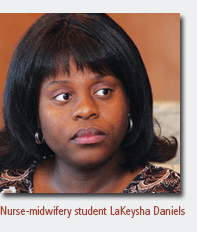 Daniels no longer thought of herself as a pioneer when she
began graduate work in Emory’s nurse-midwifery program,
so she was shocked to find herself one of only three minority
students in class.
Daniels no longer thought of herself as a pioneer when she
began graduate work in Emory’s nurse-midwifery program,
so she was shocked to find herself one of only three minority
students in class.
“I was furious,”
Daniels says, “but then I started to see that it wasn’t
about people not wanting to move forward. The lack of minority
student enrollment is the result of many potential African
American students not knowing what Emory has to offer and
what steps to take to further their nursing career. I have
had a tremendously positive and welcoming experience as a
graduate student in the School of Nursing. Realizing the torch
was being passed to me from other pioneering nurses, I asked
Dean Salmon if we could form a graduate student organization
to stay in touch with alumni and encourage future minority
graduate students to embrace the Emory experience. She was
very excited and connected me to the right people. It’s
a work in progress, but we’re reaching out in the right
direction.”
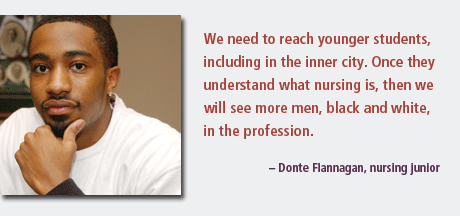
Donte Flanagan is a junior in
the school who plans to continue in the school’s graduate
emergency nurse practitioner program, specializing in pediatrics.
He knows it’s even harder to draw in students who look
like him. The nursing school graduated its first male undergraduate
in 1968, and its first black male undergraduate in 1972. Today,
men make up 7% of undergraduate nursing students and 5% of
graduate students.
“Bright men in the African
American community are encouraged to enter high-status fields
like medicine or law,” Flanagan says, speaking from
experience. “There is still stigma associated with helping,
serving professions. People don’t realize the respect
nurses have, the increasingly high salaries and opportunities
for advancement, until they are actually out in the world.”
He believes that’s why many of his classmates have previous
degrees and have chosen nursing as their second career.
As a mentor in his Tennessee
hometown, Flanagan tries to tell young people, especially
young black men, that nursing is a “critical-thinking
profession,” allowing practitioners to combine the science
of medicine with the compassion that is in all humans. He
also tells them that, with the nursing shortage and the broadening
roles nurses play in health care, willing students of any
economic background can find the resources to become nurses.
“We need to reach younger
students, including in the inner city,” he says. “Once
they understand what nursing really is, then
we will see more men, black and white, in the profession.”
“It was great to be first,”
says Bellamy, “but if you walk through a door and no
one follows you, then it’s no longer worthwhile. It’s
not an honor anymore.” She’s encouraged by what
she sees happening at Emory and in the nursing school. The
university has the highest enrollment of black students in
the country among the nation’s 25 leading universities
and about twice the national average of black faculty. It
is becoming increasingly diverse internationally.
The nursing school’s enrollment reflects the United
States’ hyphenated population—19% and 23% African
American in the undergraduate and graduate programs, respectively;
5% and 6%, Asian American/Pacific Islander; and 2% Latin American
in both programs. Other minorities make up 7% and 5%.
But admitting minorities is
one thing, making sure they graduate is another. Five years
ago, noticing African American students were more likely to
drop out,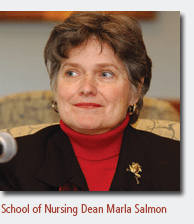 Salmon instigated a pre-admissions test for all students to
pinpoint possible gaps in undergraduate preparation—and
a summer program where students could fill those gaps before
joining better-prepared classmates in the fall. Today, more
than 90% of undergraduate nursing students graduate—and
the drop-out rate is no longer related to color.
Salmon instigated a pre-admissions test for all students to
pinpoint possible gaps in undergraduate preparation—and
a summer program where students could fill those gaps before
joining better-prepared classmates in the fall. Today, more
than 90% of undergraduate nursing students graduate—and
the drop-out rate is no longer related to color.
Like early heroines in the nursing
school, Salmon and her faculty still want to change the world—and
they are still in a hurry. The portrait of Ada Fort hangs
in the board room a few doors down from the dean’s office.
Her gaze seems to move around the room, watching while faculty
discuss the present and plan for the school’s next 100
years.
“Some days I go in there
and she’s smiling,” says Salmon. “Other
days I go in and her eyebrow is lifted, she’s looking
right at me, and she’s saying ‘now, now, now.’
”
Sylvia
Wrobel recently retired as associate vice president for health
sciences communications after 22 years at Emory University.
|
 |
|
|
|
|